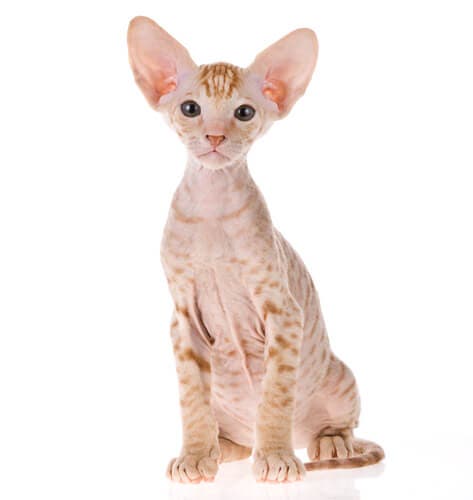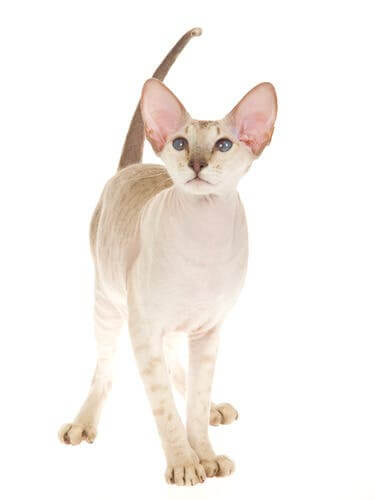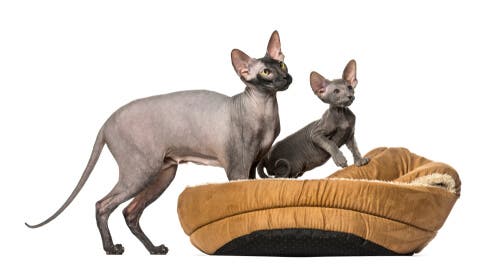All About the Peterbald Cat Breed

Can you picture yourself with a slender, hairless feline with oblique eyes and large pointed ears as a pet? We’re talking about none other than the Peterbald cat breed, one of the many hairless breeds that man has created in recent times. And since this cat is also playful and affectionate, you may want to consider one as your next pet.
A cat from St. Petersburg
The Peterbald cat has its origins in Russia. More specifically, it comes from St. Petersburg, the second-largest city in this country.
The creator behind the Peterbald cat breed is amateur feline judge Olga Miranova. In 1994, she managed to create a hairless cat that set itself apart from the then-popular Sphynx.
Since Miranova was looking for a lighter breed, she crossed Siamese Cats, Oriental Shorthairs, and Don Sphynx cats–now known as Donskoys. The result led to the first specimens of this peculiar breed, which soon earned the recognition of the principal feline associations. What’s more, it gained popularity around the world.
The Peterbald was created in Russia in the mid-1980s and is a hairless cat breed. It’s an elegant feline with an oriental appearance, characterized by being affectionate and dependent on its owners.
The physical characteristics of the Peterbald cat breed
This elegant domestic cat can be absolutely bald or possess a very thin and imperceptible coat of fur–only about 1/2 and inch long. There are also specimens that have longer fur than this.

Every once in a while, one of these cats may not inherit the bald gene and will get a normal coat. As for their color, Peterbalds can come in any color and any combination.
Other characteristics that describe the Peterbald cat breed are the following:
- Size: Medium
- Weight: Between 6.5 and 11 pounds.
- Body: Long and muscular.
- Head: Triangular and proportionate, and medium in size.
- Eyes: Almond-shaped and medium-sized. Not too prominent, with a color that matches their coat.
- Profile: Straight, without a stop.
- Snout: Fine.
- Nose: Straight and long.
- Tail: Long, with a pointed tip.
- Extremities: Long, like those of a ballerina.
The nature of the Peterbald cat breed
Calm, stable, affectionate, and very sociable… These are the perfect words to describe the nature of the Peterbald cat breed. It’s an animal that constantly seeks the attention of its owner and wants to be pet and cuddled. It’s common for these cats to follow their owners around the house wherever they go.
They’re not just sweet and loving, but also active and intelligent. These endearing hairless cats tend to pay attention to everything around them and love to play, especially with their owners. They make excellent pets, even if you have other animals in the home. What’s more, they tend to be especially patient with children.

However, these cats hate to be alone. Therefore, if your entire family leaves the house on a daily basis or for several hours, it’s best to give your Peterbald another feline companion. Or, you could also choose a dog to keep it company.
Caring for your Peterbald cat
All hairless cats require specific care, which includes protecting them from both hot and cold temperatures. However, unlike other hairless cats, Peterbalds don’t require constant grooming.
Their skin, in comparison to that of other cats, produces very little sebum. Therefore, you just need to wash them with a moist towel. Your vet can indicate the best type.
Just the same, if you want to give your cat a bath, you’re free to do so–especially when it’s hot outside. In this sense, it’s best to get them used to water from when they’re little.
At the same time, as with any pet, it’s important to provide them with good quality food according to their metabolism. Also, be sure to keep their vaccines and worming up to date to keep your pet from suffering from serious health problems. The average life expectancy of these cats is between 12 and 16 years.